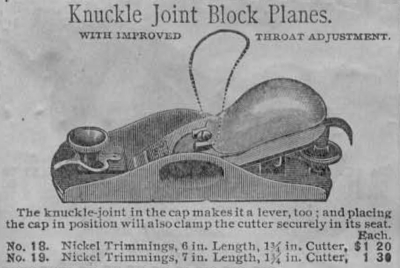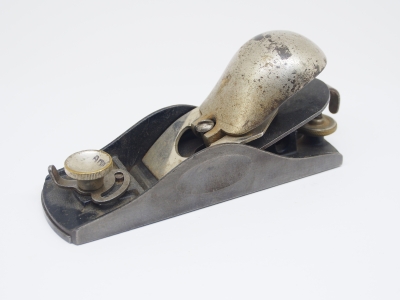One of the more unique features of block planes is the depression often found on the outer face of the planes side walls – known more commonly as the “handy“. The depressions are designed for the thumb and forefinger to be situated while holding the plane. This feature was first described by J.A.Traut in his 1897 design patent (No.24,474) – “Design for a plane-body”. Each of the planes walls has “a concavity in its outer face elongated and substantially elliptical in shape“. Traut never really describes the purpose of the depressions, beyond mentioning that they produce a “figure harmonizing in appearance with the general outline of said plane-body”.

A picture from Traut’s original patent.
The patent had a term of 14 years, meaning that by 1911 other companies could start using the feature in their designs. However many plane manufacturers were using similar type depressions before the patent expired. This occurred because the patent was a design patent, i.e. it does not protect the functional aspects of a plane, and the handy certainly could be considered a functional aspect. Both Sargent and Millers Falls also had elliptically-shaped finger depressions. However neither is what could be considered “substantially elliptical” in shape, as posed by Traut’s patent – which may be the point.

The Ohio Tool Company went the opposite way and decided on a circular depression, which was not as ergonomic as the elliptical ones. Stanley also used a circular hole as the “handy” in their pressed steel block planes. Hobbies (UK) took a different approach to the problem, and used a series of vertical grooves on the outside of the plane wall.

Modern plane manufacturers have tended to steer away from the elliptical shape, except for the Lie Nielsen, however the size of their depression is much smaller, 50% the size of the original Stanley “handy”. Lee Valley use two different finger depressions: (1) a series of three different circular depressions of differing diameters, or (2) an alcove cut directly into the side of the plane (found on their apron plane).

Ironically, even Stanley have moved away from elliptical depressions, opting instead for a single circular depression.









